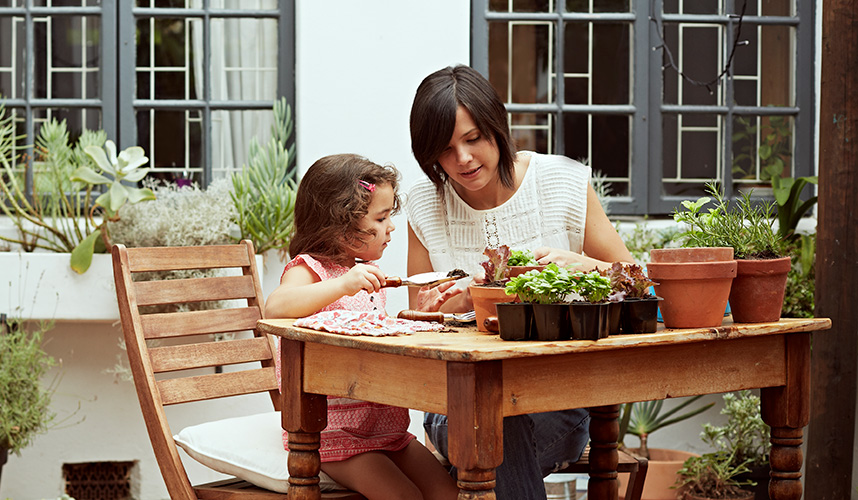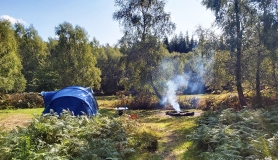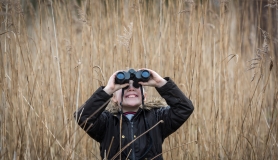1 GROW YOUR OWN
Children love planting seeds, watching the tiny seedlings burst up through the soil, and even a kitchen window sill can be transformed into a mini greenhouse that will help your child to learn first hand about food and where it comes from. This becomes even more important when children see the local supermarket as the source of all their food. It is important for children to understand that tomatoes do not originate from tins on supermarket shelves. If they have had the chance to plant the seeds themselves, watch them grow and then eat the final produce it really brings learning to life. Obviously a small vegetable patch in your own garden is ideal but it isn’t at all necessary. Plants can be grown in containers on patios, balconies and even window sills, depending on the space you have available. Simply choose your plants carefully, your local garden centre will be happy to offer advice and most libraries stock a range of gardening books, some aimed at children. Many towns run allotment schemes and it is worthwhile phoning your local council to find out if there are any plots vacant in your area. The annual price is usually very reasonable and you have the added benefit of saving money by growing your own produce.
WHY NOT TRY
MAKING A TYRE PLANTER Paint two or three old car tyres using bright emulsion paint and, when they are dry, stuff the rim inside each tyre with balls of newspaper. Stack the tyres on top of each other and pour in a layer of gravel, small stones or pottery chips for drainage. Fill up the stack with ordinary potting compost and plant with small, edible plants such as marigolds, lavender, oregano, step over apples, lettuce and strawberries.
RECYCLING AN OLD FOOTBALL Cut the crown from an old or punctured ball and carefully make a few holes in the bottom with a sharp knife to allow water to drain out. Fill the ball with potting compost and plant with small bedding plants or herbs.
2 TAKE A NATURE WALK
Wildlife flourishes even in the most urbanised areas, the secret is to know where and what to hunt for. Keep a diary of your walks and explore different areas each week. Churchyards, docks, small areas of waste ground, parks, allotments and even residential streets, will all provide a wealth of wildlife encounters. Make sure that the areas are safe and that young children are well supervised.
LOOK OUT FOR
ANIMALS Grey squirrels are common in parks, gardens and churchyards but they also forage for food in dustbins along residential streets and in city centres.
PLANTS Lichens, mosses and ferns grow almost anywhere and the different types can be used to indicate pollution levels in an area. Look on walls, paving stones, railings, tombstones and statues. Churchyards and small areas of waste ground can become havens for wildflowers such as poppies, shepherd’s purse, traveller’s joy and celendine, as well as native trees like rowan and hawthorn.
INSECTS Insects and invertebrates thrive wherever they can find shelter and food. A stone wall can harbour an amazing array of creatures from snails, slugs, ants and spiders to millipedes, woodlice and ladybirds. Check the undersides of leaves, peer into paving cracks and peek under stones and branches (always putting them back carefully). BIRDS Pigeons, starlings, sparrows and wagtails are common throughout all built up areas as they scavenge for food among the street litter and, in turn, they provide food for birds of prey, such as peregrine falcons, who build their nests on the ledges of high-rise buildings. Parks and gardens are quieter havens for blackbirds, thrushes, bluetits and even goldcrests. WHY NOT TRY Hanging a bird feeder from a tree in your garden or local park, or from a balcony or window. Fill it with nuts and seeds and see which birds come to visit.
3 CELEBRATE
Surrounded by trees changing colour, crops being sown and harvested, the scents of pollen or drying hops, it is easy to appreciate the subtle changes and rhythms of nature. Living in a city may not provide this holistic experience, but children can still learn about the seasons and cycles of nature in other ways. Many festivals and celebrations originate from a reverence and respect for the processes of nature. At harvest time, churches are decorated with candles, wheat sheaves, poppies and autumn fruits, the congregation sings traditional songs of thanksgiving for the harvest that year and everyone offers gifts of food which are then taken to a local shelter, residential home or community centre where they will provide meals for those who are less fortunate. Winter is full of celebrations of light, such as Diwali and Samhain (Halloween). It is the dark, liminal time before spring, when the sun is reborn and we can celebrate new life again. In winter, seeds and fruits that have been harvested are now turned into jams, pickles, chutneys and candies to cheer up the months when the trees and hedgerows are bare. Celebrate this time in the kitchen together, making mincemeat and other seasonal preserves. Talk about the need to do this years ago when people had to rely on their own harvests and skills of preservation in order to survive.
WHY NOT TRY Eggs make great decorations. Take one raw egg and, with a pin, carefully make a tiny hole at one end and a slightly larger hole at the other. Hold the egg over a bowl or plate and blow through the tiny hole so that the yolk and white spill out and are caught in the bowl. Set aside and use for baking a cake later. Now half fill a separate bowl with water and place on a sheet of newspaper to protect your work surface. Add about a tsp of vinegar and a few drops of food colouring to the water then place the eggshell into the bowl. Leave for about a minute, remove using a tablespoon and leave to dry. Finish by brushing lightly with cooking oil. The finished eggs look lovely displayed in a basket or hung on branches arranged in a large vase.
4 LOOK UP
You don’t need any expensive equipment to explore the sky’s features during both the daytime and at night. The sun, clouds, moon and many constellations can all be seen with the naked eye and tracking their changes through days, weeks, months and a year is yet another way of involving children in the great patterns and cycles of the natural world.
WHY NOT TRY
MAKING YOUR OWN WEATHER FORECASTS Look at the different types of clouds in the sky each morning and evening and see if you can deduce what the weather is likely to be. Cumulus These clouds look like white cotton wool balls. They may produce light showers. Cumulo nimbus The same shape as cumulus but darker and sometimes with a wispy top. These clouds usually produce heavy rain, and sometimes hail, snow or even lightning. Stratus A grey layer of cloud. It usually starts low in the morning as fog and rises to disappear during the day.
STAR HUNTING Look out for these common constellations, visible at different times of the year. Try making a star chart of your sightings each month, using white chalk on black paper, and watch how the constellations move across the sky. Orion (the hunter) is one of the most easily recognisable constellations, with his belt of three bright stars. It is visible from December to April in the northern sky. Ursa Major and Minor (the great bear and the little bear) are visible from March to September in the northern sky as they are chased from their lair, Corena Borealis, and pursued across the heavens by a pack of hunting dogs. Sirius (the dog star) is part of the constellation Canis Major and is the brightest star in the northern sky. The constellations Canis Major and Canis Minor are visible in the northern sky from April to December as they hunt at the feet of Orion, their master. Lepus (the hare) runs at the feet of Orion and is hunted across the sky by the hunter’s dogs, Canis Major and Canis Minor.
MAKING A MOON CHART The moon is visible in phases and takes approximately one month to complete each cycle. Make a sketch of the moon each evening and watch as its silver disc slowly disappears, only to re-emerge again sliver by sliver, returning once more to its full state.
5 GET A TORCH OUT
Many animals, such as foxes, badgers and hedgehogs, sleep during the day, emerging at dusk to scavenge food from dustbins and kerb-sides. Choose a safe route and check during the daytime for footprints, droppings or food sources that might indicate that an animal uses that route at night. Then return to walk the route as the streets begin to get dark. It might take a few tries before you make an actual sighting, but animals tend to use the same routes at the same times each night, so once you have spotted your nocturnal visitor, you can expect to see her each time you visit the spot. Take care to stay quiet and not disturb the animal.
WHY NOT TRY Most areas, both urban and rural, have their own wildlife groups who offer special evenings when the public can join them. They visit sites where sightings of badgers, foxes or bats are almost guaranteed and are well worth getting involved in. Try contacting your local council, vet or animal sanctuary for more information about wildlife groups near you. See urbanwildlife.org.uk or wildlifetrusts.org.uk







